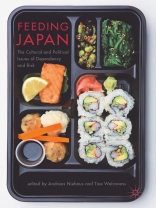This edited collection explores the historical dimensions, cultural practices, socio-economic mechanisms and political agendas that shape the notion of a national cuisine inside and outside of Japan. Japanese food is often perceived as pure, natural, healthy and timeless, and these words not only fuel a hype surrounding Japanese food and lifestyle worldwide, but also a domestic retro-movement that finds health and authenticity in ‘traditional’ ingredients, dishes and foodways. The authors in this volume bring together research from the fields of history, cultural and religious studies, food studies as well as political science and international relations, and aim to shed light on relevant aspects of culinary nationalism in Japan while unearthing the underlying patterns and processes in the construction of food identities.
Содержание
Introduction: Reconsidering Japanese food; Andreas Niehaus and Tine Walravens.- Part I: Inventing Japanese Food Identities.- 2.“They should be called gluttons and be despised”: Food, Body and Ideology in Kaibara Ekiken’s Yōjōkun (1713); Andreas Niehaus.- 3. ‘Sweets Reimagined’: The Construction of Confectionary Identities, 1890-1930; Mitsuda Tatsuya For Gluttons, Not Housewives: Japan’s First Gourmet Magazine, Kuidōraku; Eric Rath.- 4. Global Recognition and Domestic Containment: Culinary Soft Power in Japan; Stephanie Assmann.- Part II: Feeding the Nation: Japanese Food Identities in Times of Globalization.- 5. Deconstructing “Kokushu”: The Promotion of Sake as Japan’s National Alcohol Drink in Times of Crisis in the Sake Industry; Dick Stegewerns.- 6. The Drink of the Nation? Coffee in Japan’s Culinary Culture; Helena Grinshpun.- 7. Forging Ahead with Bread: Nationalism, Networks and Narratives of Progress and Modernity in Japan Sheng Annie.- 8. Joining the Global Win
e World: Japan’s Winemaking Industry; Wang Chuanfei.- Part III: Japanese Food Industries Inside-Out.- 9. Chinese Food Threatening the Japanese Table: Changing Perceptions of Imported Chinese Food in Japan; Tine Walravens.- 10. Domesticating the Japanese Culinary Field in Shanghai; James Farrer.- 11. Ḥalāl Foods Discourse and Constructing Muslim Identities in Japan; Ono Junichi.- 12. Eating Japanese – Being Japanese: Ethnic Food in Hawai’I; Jutta Teuwsen.- Part IV: Agricultural Politics of Self-Suffiency and Dependency.- 13. Japan in the International Food Regimes: Understanding Japanese Food Self-sufficiency Decline; Felice Farina.- 14. The Trans-Pacific Partnership, Import-Dependency, and the Future of Food Security in Japan; Paul O’Shea.- 15. Subsidized Tradition, Networks, and Power: Hamlet Farming in Japan’s Changing Agricultural Support and Protection Regime; Hanno Jentzsch.- Part V: Post-Fukushima Food Education and Food Safety.- 16. Eating School Lunches Together after the Fukushima Accident; Kimura Aya H.- 17. National Solidarity of Food Insecurity: Food Practice and Nationalism in Post- 3/11 Japan; Takeda Hiroko.- 18. Discourse on Food Safety and the Trans-Pacific Partnership (TPP): Perspectives from Japan; Cornelia Reiher.Об авторе
Andreas Niehaus is Head of the Department Languages and Cultures at Ghent University, Belgium. His research focuses on early-modern and modern Japanese body culture, sport history as well as cultural and national identities.
Tine Walravens is a Research Assistant at the Institute of Japanese Studies, Ghent University, Belgium. Her research is on the politics of food and food safety in East Asia, in particular Japanese consumer trust and food risk.












